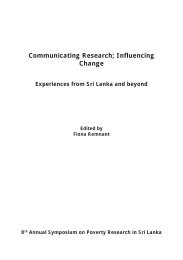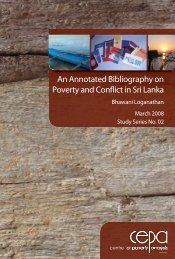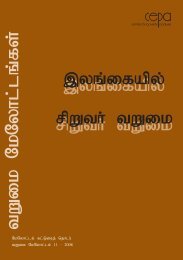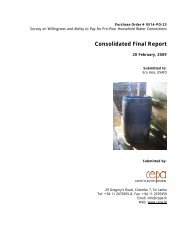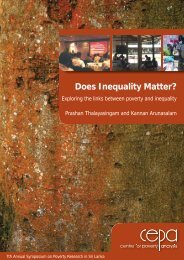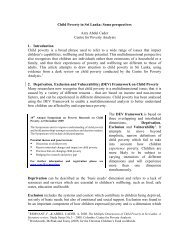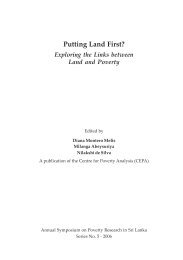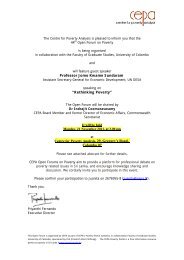Involuntary Displacement and Resettlement â Policy and ... - CEPA
Involuntary Displacement and Resettlement â Policy and ... - CEPA
Involuntary Displacement and Resettlement â Policy and ... - CEPA
- No tags were found...
Create successful ePaper yourself
Turn your PDF publications into a flip-book with our unique Google optimized e-Paper software.
1 IntroductionThis paper is based on the Making Peace - Keeping Peace study(Thalayasingam et al., 2009) conducted by the Poverty <strong>and</strong> Conflict (PAC)programme of the Centre for Poverty Analysis. The study focussed on twoaspects of community relations <strong>and</strong> conflict in the Puttalam district:“Making Peace” − how incidents of conflict in the area have beendealt with in the past.“Keeping Peace” − how communities <strong>and</strong> local organisations havebeen able to manage conflict <strong>and</strong> sustain these situations.The study concept was suggested by a local partner, the Vinividha NGOcoalition. They suggested that the conflict dynamics in the district <strong>and</strong> theirmeans of resolution would provide insights for other actors working withother conflict affected communities. Following many rounds of qualitativedata collection, the team chose six conflict incidents to follow as casestudies. The conflicts were based on issues illustrative of the wider conflictdynamics in the district <strong>and</strong> were resolved by a range of actors that localcommunities used for this purpose. The choice of conflict lines alsodetermined the geographical focus of the study. It focused on four divisionalsecretariat (DS) divisions − Mundal, Vanathavilluva, Puttalam <strong>and</strong> Kalpitiya −all with different levels of ethnic heterogeneity <strong>and</strong> different histories ofhosting internally displaced persons (IDPs).The study finds that the main cause of conflict in the district during the studyperiod (2006-2008) was the deteriorating relationship between the hostcommunity <strong>and</strong> the IDPs. The study also identified further sources ofconflict, including ethnic identity based competition, religious identity basedcompetition <strong>and</strong> competition between political groups. This paper focuseson IDP - host relations <strong>and</strong> its role in conflict in the district.The changing <strong>and</strong> contested vulnerability is the root cause of many of theconflicts. The host community perceives that many other vulnerable groupsreceive very little support <strong>and</strong> assistance, while IDPs, despite their long stay,<strong>and</strong> despite the fact that many of them have significantly improved theirliving conditions, asset bases <strong>and</strong> commercial links during their longdisplacement, continue to be specially supported. The IDPs <strong>and</strong> theirrepresentatives contend that they are still vulnerable <strong>and</strong> retain the112



